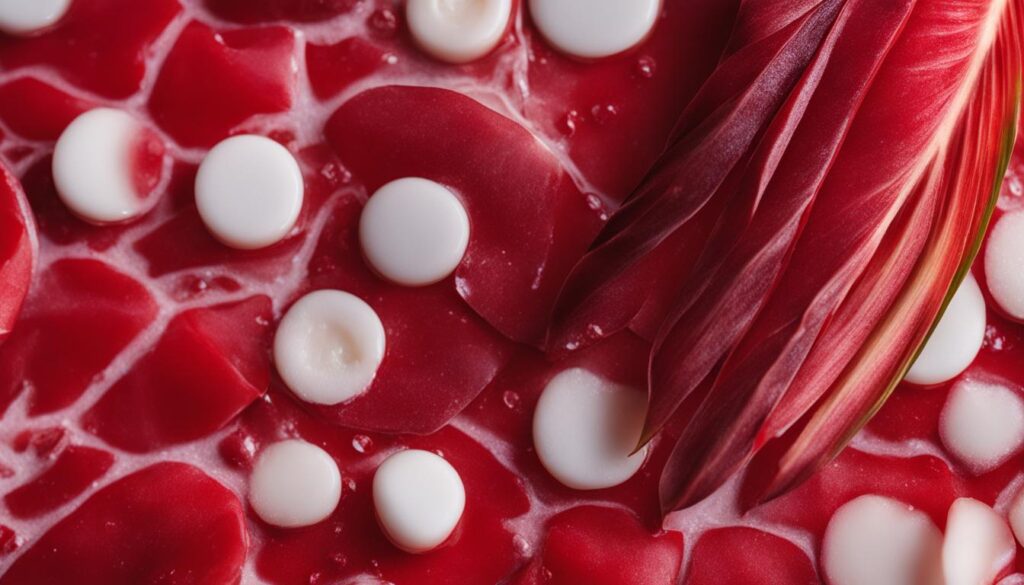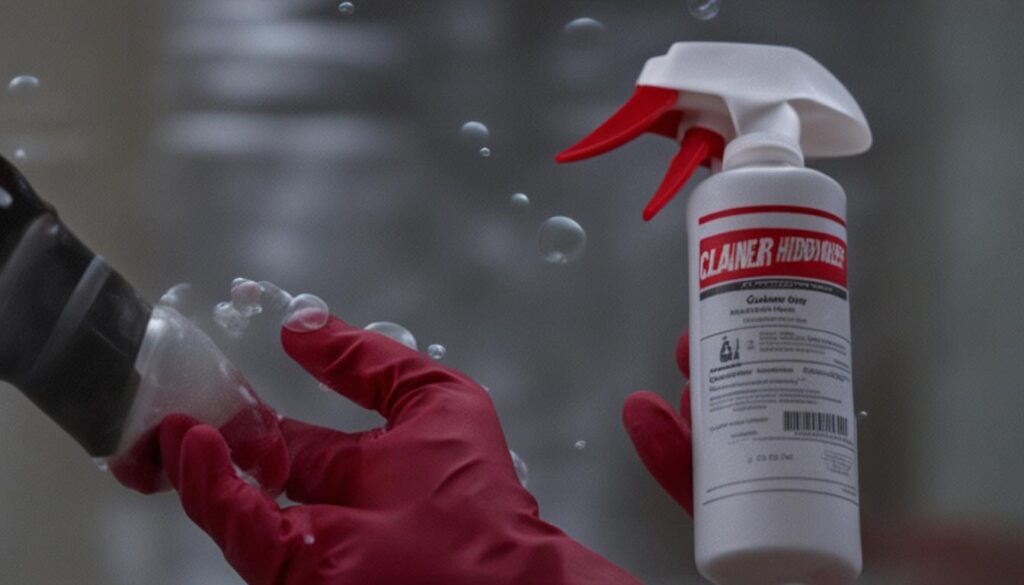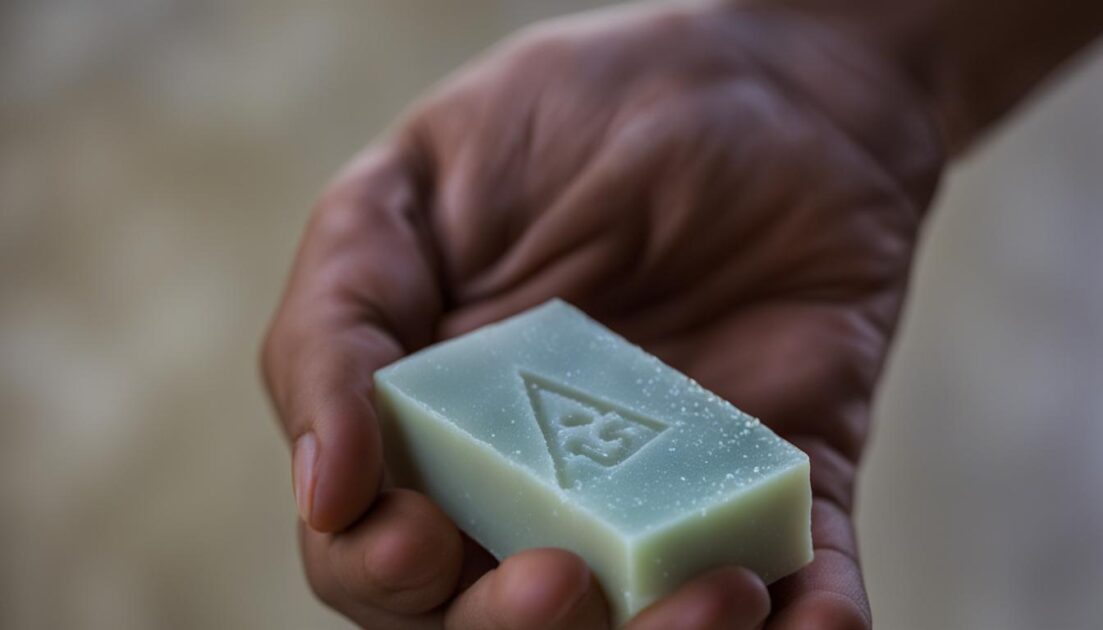When it comes to skincare, there are countless ingredients that can be beneficial for our skin. One such ingredient is sodium hydroxide, also known as lye or caustic soda. It might sound intimidating, but sodium hydroxide is actually a common additive in many skincare products. However, like any ingredient, it’s important to understand its safety and uses to ensure we’re making informed choices for our skin.
Sodium hydroxide is primarily used in skincare to help balance and maintain the pH of products. It is also utilized for its ability to facilitate the saponification process in soap making. However, it’s crucial to note that pure sodium hydroxide should never be applied directly to the skin. Instead, it is used in small amounts within skincare products to provide its benefits without causing harm.
Now, let’s dive deeper into the safety precautions, pH balance implications, and potential side effects of sodium hydroxide in skincare.
Key Takeaways:
- Sodium hydroxide is a common ingredient in many skincare products.
- It is used to help balance and maintain the pH of skincare products.
- Pure sodium hydroxide should never be applied directly to the skin.
- Perform a patch test before using a new product containing sodium hydroxide.
- Consult with a dermatologist if you have sensitive skin or any skin conditions.
Sodium Hydroxide in Skincare: Safety Precautions
When it comes to using skincare products that contain sodium hydroxide, it’s essential to prioritize safety. While sodium hydroxide is generally considered safe for use in small amounts, it’s important to follow specific precautions to avoid any potential risks or adverse effects. Whether it’s for skin lightening, soap making, or other cosmetic applications, understanding the safety measures is crucial.
The Importance of Using Sodium Hydroxide in Skincare Products Responsibly
Sodium hydroxide is a common ingredient in cosmetic products, including skincare formulations. It is often used for its pH-balancing properties and its role in the saponification process in soap making. However, it’s important to note that pure sodium hydroxide should never be applied directly to the skin. Its highly alkaline nature can cause chemical burns and severe skin damage. It is paramount to use skincare products containing sodium hydroxide in small amounts and at lower concentrations to minimize the risk of adverse reactions.
Cautions for Individuals with Sensitive Skin
If you have sensitive skin, it’s essential to be cautious when using skincare products that contain sodium hydroxide. While generally considered safe, sodium hydroxide can still cause irritation, redness, or other unwanted reactions on sensitive skin. Performing a patch test before using a new product is recommended. Apply a small amount of the product on a small area of skin and observe for any signs of irritation or allergic reactions for 24 hours. If any adverse effects occur, discontinue use immediately.
Sodium Hydroxide in Cosmetic Products
Sodium hydroxide is commonly found in various cosmetic products, ranging from skincare to hair care and nail care. This ingredient helps to maintain the pH balance of the products and enhance their stability and effectiveness. Some cosmetic products, such as skin lightening formulations, may also contain sodium hydroxide. However, it’s important to note that these products should be used with caution and according to the manufacturer’s instructions to minimize the potential for skin irritation or damage.
The Role of Sodium Hydroxide in Soap Making
In soap making, sodium hydroxide plays a critical role in the saponification process, transforming fats and oils into soap. It helps ensure proper mixing and the formation of a well-balanced soap bar. However, it’s vital to exercise caution when working with sodium hydroxide during the soap-making process. Protective equipment, such as gloves and goggles, should be worn to prevent direct contact with the skin or eyes. It’s also important to handle sodium hydroxide in a well-ventilated area to avoid inhaling any fumes.
Sodium Hydroxide and pH Balance for Skin
Sodium hydroxide plays a crucial role in maintaining the pH balance of skincare products. The pH of the skin is naturally slightly acidic, ranging from 4 to 7 on the pH scale. The acidic pH helps to protect the skin from bacteria, viruses, and environmental toxins. Sodium hydroxide, being highly alkaline, is used in skincare products to help balance and maintain the skin’s pH. This is important for keeping the skin’s acid mantle intact, which is responsible for retaining moisture and protecting against various skin issues like acne, dryness, and fine lines. It is essential to maintain a balanced pH to ensure optimal skin health.

The pH scale measures the acidity or alkalinity of a substance, ranging from 0 to 14. A pH value of 7 is considered neutral, while values below 7 are acidic, and values above 7 are alkaline. The skin’s natural pH typically falls between 4 and 7, making it slightly acidic. This acidic environment helps to protect the skin by inhibiting the growth of harmful bacteria and maintaining the skin’s barrier function.
Skincare products that contain sodium hydroxide serve to balance the skin’s pH. By adjusting the pH to a suitable range, these products help restore and maintain the skin’s natural acidic state. This is particularly important for individuals with dry or sensitive skin, as an imbalanced pH can disrupt the skin’s moisture barrier and lead to irritation, dryness, and other skin concerns.
When the skin’s pH is unbalanced, various skin issues can arise. For example, an overly acidic pH can contribute to excessive oiliness and acne breakouts, while an overly alkaline pH can cause dryness, irritation, and increased sensitivity. By incorporating skincare products that contain sodium hydroxide, the pH balance can be restored, promoting healthier-looking skin.
Sodium Hydroxide and Skin Care Products
Sodium hydroxide is a versatile ingredient commonly found in various skin care products. It is used in soap, face wash, body cream, lotion, makeup, hair dye, nail polish, and nail polish remover. This ingredient serves multiple purposes in these products, such as helping to maintain the pH balance and enhancing their effectiveness.
One of the important applications of sodium hydroxide is in soap making. It plays a crucial role in the saponification process, where oils and fats react with sodium hydroxide to produce soap. This reaction helps create a well-mixed soap that cleanses and nourishes the skin effectively.
In cosmetic products, sodium hydroxide ensures stability and maintains the desired efficacy. By helping to balance the pH levels, it supports the product’s performance and desired effects on the skin.

When used appropriately, products containing sodium hydroxide can provide numerous benefits for the skin. However, it is crucial to consider individual skin type and sensitivity, as well as follow recommended usage guidelines.
Sodium Hydroxide and Skin Sensitivity
While sodium hydroxide is generally safe for use in skincare products, individuals with sensitive skin may be more prone to experiencing adverse reactions. It is always recommended to perform a patch test before using a new skincare product, especially if it contains sodium hydroxide. A patch test involves applying a small amount of the product to a small area of skin and waiting for 24 hours to observe any signs of irritation or allergic reactions. If any itching, redness, or other adverse effects occur, it is best to avoid using the product. Additionally, individuals with skin conditions such as eczema, psoriasis, cystic acne, or rosacea should consult with a dermatologist before incorporating skincare products that contain sodium hydroxide into their routine.
It’s important to prioritize skin safety and choose products that are suitable for your specific skin type and condition. Consulting with a dermatologist can provide personalized advice and guidance on skincare regimen, including the appropriate use of products containing sodium hydroxide. By taking these precautions, individuals with sensitive skin can ensure both the health and beauty of their skin.
The Patch Test: A Simple and Effective Safety Measure
The patch test is a straightforward method to assess how your skin reacts to a particular product. By performing a patch test, you can minimize the risk of adverse effects and make an informed decision about using a skincare product that contains sodium hydroxide. Here’s how to conduct a patch test:
- Clean a small area of skin, preferably on the inside of your forearm or behind your ear.
- Apply a small amount of the product containing sodium hydroxide to the cleaned area.
- Leave the product on the skin for 24 hours without washing it off.
- Observe the patch test area for any signs of irritation, redness, itching, or other adverse reactions.
- If no adverse effects occur, it is likely safe to use the product. If any negative reactions appear, it is best to avoid using the product.
“Prioritizing skin safety is essential, especially for individuals with sensitive skin. Performing a patch test before using a skincare product can help identify potential allergic reactions or sensitivities to sodium hydroxide.” – Dermatologist Dr. Rachel Johnson
It is important to remember that sensitivity to sodium hydroxide can vary from person to person. What may be safe for one person might cause an adverse reaction in another. Therefore, it is crucial to pay attention to your skin’s response and adjust your skincare routine accordingly. If you experience any discomfort or irritation, discontinue use and seek advice from a healthcare professional or dermatologist.
| Skin Reaction | Possible Symptoms |
|---|---|
| Irritation | Redness, itching, burning sensation |
| Allergic Reaction | Rash, hives, swelling |
| Skin Sensitivity | Dryness, flaking, increased sensitivity to other products |
Sodium Hydroxide in Cleaning Products
Sodium hydroxide, commonly known as caustic soda, is not only used in skincare but also in various cleaning products. It is a critical ingredient in laundry detergent, drain cleaner, and oven cleaner, among others. The powerful cleaning properties of sodium hydroxide make it effective in breaking down grease, oil, and other stubborn stains.
However, it is important to note that cleaning products containing sodium hydroxide should never be applied directly to the skin. Sodium hydroxide is highly corrosive and can cause severe burns and skin damage. To ensure your safety while using cleaning products with sodium hydroxide, it is essential to take precautions like wearing gloves and avoiding direct contact with the skin.

Remember:
- Do not apply cleaning products containing sodium hydroxide to the skin.
- Wear gloves to protect your hands when handling cleaning products with sodium hydroxide.
- Store cleaning products safely and out of reach of children or pets.
Potential Side Effects of Sodium Hydroxide
While sodium hydroxide is generally safe for use in skincare products, it is important to be aware of the potential side effects, especially for individuals with sensitive skin. Some of the possible side effects include:
- Hives: Raised, itchy welts on the skin.
- Rash: Red, irritated patches of skin.
- Itching: Persistent and uncomfortable feeling on the skin.
- Redness: Skin appears reddened or flushed.
- Dryness: Skin feels tight, flaky, or dehydrated.
- Increased Skin Sensitivity: Skin becomes more reactive to other products or environmental factors.
If you experience any of these side effects after using a skincare product containing sodium hydroxide, it is important to discontinue use and seek medical advice if necessary. It may also be helpful to perform a patch test before using a new product to identify any potential allergic reactions or sensitivities.
Side Effects of Sodium Hydroxide
| Side Effects | Description |
|---|---|
| Hives | Raised, itchy welts on the skin |
| Rash | Red, irritated patches of skin |
| Itching | Persistent and uncomfortable feeling on the skin |
| Redness | Skin appears reddened or flushed |
| Dryness | Skin feels tight, flaky, or dehydrated |
| Increased Skin Sensitivity | Skin becomes more reactive to other products or environmental factors |
“It is crucial to pay attention to potential side effects and discontinue use if any adverse reactions occur.” – Dr. Jane Miller, Dermatologist
When using skincare products, it is always important to prioritize the health and safety of your skin. By staying informed about potential side effects and taking necessary precautions, you can make informed decisions about the use of sodium hydroxide-containing products.
The Bottom Line on Sodium Hydroxide for Skin
In conclusion, sodium hydroxide is a common ingredient in many skincare products and is generally considered safe for use in small amounts. It plays a crucial role in balancing the pH of skincare products and facilitating the saponification process, which enhances their effectiveness.
However, it is important to exercise caution when using skincare products that contain sodium hydroxide, particularly if you have sensitive skin. Performing a patch test before incorporating a new product into your routine can help identify any potential adverse reactions.
Consulting with a dermatologist is also advisable, especially if you have pre-existing skin conditions or concerns. They can provide personalized guidance on the safe use of sodium hydroxide-containing products and recommend alternatives if needed.
When used appropriately, sodium hydroxide can contribute to optimal skin health by maintaining pH balance and ensuring the efficacy of skincare products. By taking necessary precautions and seeking professional advice, you can safely enjoy the benefits of sodium hydroxide in your skincare routine.
FAQ
Is sodium hydroxide safe for skin?
Sodium hydroxide is generally safe for use in small amounts in skincare products. However, pure sodium hydroxide should never be applied directly to the skin as it can cause chemical burns and severe skin damage.
What is the role of sodium hydroxide in skincare products?
Sodium hydroxide is used in skincare products to help balance and maintain the pH, facilitate the saponification process in soap making, and enhance the stability and effectiveness of the products.
Can sodium hydroxide be used for skin lightening?
Sodium hydroxide is commonly found in cosmetic products, including those used for skin lightening. However, it is important to use these products in moderation and follow the instructions to avoid any potential adverse effects.
How does sodium hydroxide affect the skin’s pH balance?
The skin’s pH is naturally slightly acidic, and sodium hydroxide, being highly alkaline, helps to balance and maintain the pH of skincare products. This is important for maintaining the skin’s acid mantle, which protects against various skin issues.
Where can sodium hydroxide be found in skin care products?
Sodium hydroxide is commonly found in various skincare products, including soap, face wash, body cream, lotion, makeup, hair dye, nail polish, and nail polish remover.
Can individuals with sensitive skin use skincare products containing sodium hydroxide?
Individuals with sensitive skin may be more prone to experiencing adverse reactions to skincare products containing sodium hydroxide. It is recommended to perform a patch test and consult with a dermatologist before using such products.
Is sodium hydroxide safe in cleaning products?
While sodium hydroxide is commonly used in cleaning products, it should never be applied to the skin as it can cause severe burns and skin damage. It is important to handle these products with care and wear gloves to protect the skin.
What are the potential side effects of sodium hydroxide on the skin?
Potential side effects of sodium hydroxide on the skin may include hives, rash, itching, redness, dryness, and increased skin sensitivity. It is important to discontinue use if any adverse effects occur.






